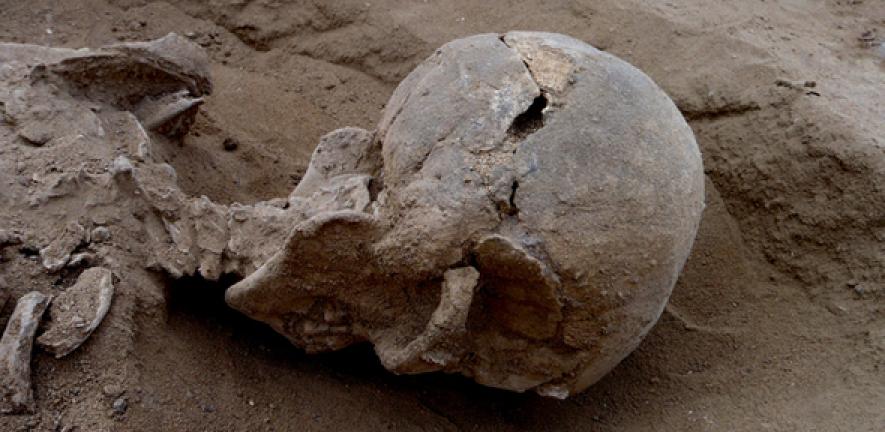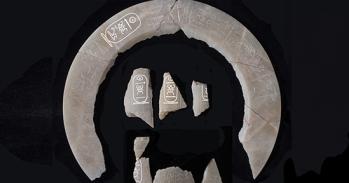
Marta Mirazon Lahr (Leverhulme Centre for Human Evolutionary Studies) discusses the discovery, made by her and her team, of the oldest known case of violence between two groups of hunter gatherers.
Marta Mirazon Lahr (Leverhulme Centre for Human Evolutionary Studies) discusses the discovery, made by her and her team, of the oldest known case of violence between two groups of hunter gatherers.
The area surrounding Lake Turkana in Kenya was lush and fertile 10,000 years ago, with thousands of animals – including elephants, giraffes and zebras – roaming around alongside groups of hunter gatherers. But it also had a dark side. We have discovered the oldest known case of violence between two groups of hunter gatherers took place there, with ten excavated skeletons showing evidence of having been killed with both sharp and blunt weapons.
The findings, published in Nature, are important because they challenge our understanding of the roots of conflict and suggest warfare may have a much older history than many researchers believe.
Shocking finding
Our journey started in 2012, when Pedro Ebeya, one of our Turkana field assistants, reported seeing fragments of human bones on the surface at Nataruk. Located just south of Lake Turkana, Nataruk is today a barren desert, but 10,000 years ago was a temporary camp set up by a band of hunter-gatherers next to a lagoon. I led a team of researchers, as part of the In-Africa project, which has been working in the area since 2009. We excavated the remains of 27 people – six young children, one teenager and 20 adults. Twelve of these – both men and women – were found as they had died, unburied, and later covered by the shallow water of the lagoon.
Ten of the 12 skeletons show lesions caused by violence to the parts of the body most commonly involved in cases of violence. These include one where the projectile was still embedded in the side of the skull; two cases of sharp-force trauma to the neck; seven cases of blunt and/or sharp-force trauma to the head; two cases of blunt-force trauma to the knees and one to the ribs. There were also two cases of fractures to the hands, possibly caused while parrying a blow.
There must have at least three types of weapons involved in these murders – projectiles (stoned-tipped as well as sharpened arrows), something similar to a club, and something close to a wooden handle with hafted sharp-stone blades that caused deep cuts. Two individuals have no lesions in the preserved parts of the skeleton, but the position of their hands suggests they may have been bound, including a young woman who was heavily pregnant at the time.

We dated the remains and the site to between 10,500 and 9,500 years ago, making them the earliest scientifically dated case of a conflict between two groups of hunter-gatherers. Stones in the weapons include obsidian, a rare stone in the Nataruk area, suggesting the attackers came from a different place.
The (pre)history of warfare
Today we think of warfare, or inter-group conflict, as something that happens when one group of people wants the territory, resources or power held by another. But prehistoric societies were usually small groups of nomads moving from place to place – meaning they didn’t own land or have significant possessions. They typically didn’t have strong social hierarchies either. Therefore, many scholars have argued that warfare must have emerged after farming and more complex political systems arose.

Naturuk therefore challenges our views about what the causes of conflict are. It is possible that human prehistoric societies simply responded antagonistically to chance encounters with another group. But this is not what seems to have happened at Nataruk. The group which attacked was carrying weapons that would not normally be carried while hunting and fishing. In addition, the lesions show that clubs of at least two sizes were used, making it likely that more than one of the attackers were carrying them.
The fact that the attack combined long-distance weapons such as arrows and close-proximity weaponry such as clubs suggests they planned the attack. Also, there are other, but isolated, examples of violent trauma in this area from this period in time – one discovered in the 1970s about 20km north of Nataruk, and two discovered by our project at a nearby site. All three involved projectiles, one of the hallmarks of inter-group conflict. Two of the projectiles found embedded in the bones at Nataruk and in two of the other cases were made of obsidian. This tells us that such attacks happened multiple times, and were part of the life of the hunter-gatherer communities at the time.
So why were the people of Nataruk attacked? We have to conclude that they had valuable resources that were worth fighting for – water, meat, fish, nuts, or indeed women and children. This suggests that two of the conditions associated with warfare among settled societies – territory and resources – were probably common among these hunter-gatherers, and that we have underestimated their role so far.
Evolution is about survival, and our species is no different from others in this respect. The injuries suffered by the people of Nataruk are merciless and shocking, but no different from those suffered in wars throughout much of our history – sadly even today. It may be human nature, but we should not forget that extraordinary acts of altruism, compassion and caring are also unique parts of who we are.
![]()
Marta Mirazon Lahr, Reader in Human Evolutionary Biology & Director of the Duckworth Collection, University of Cambridge
This article was originally published on The Conversation. Read the original article.
The opinions expressed in this article are those of the individual author(s) and do not represent the views of the University of Cambridge.

The text in this work is licensed under a Creative Commons Attribution 4.0 International License. For image use please see separate credits above.




